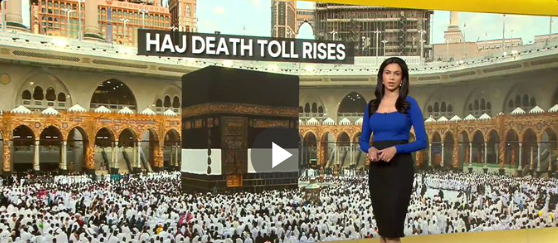Back decades ago, it was not uncommon for tens of thousands to perish in the desert on the way to Mecca. Now, 1,300 is a large number, knowing that measures can be taken to keep people alive.
This year’s Hajj pilgrimage in Saudi Arabia saw an alarming number of fatalities, with more than 1,300 people losing their lives, predominantly due to extreme temperatures at the sacred sites. Saudi Health Minister Fahd bin Abdurrahman Al-Jalajel revealed that 83% of those who died were unauthorized pilgrims who had journeyed on foot to participate in the rituals in and around Mecca, often under harsh conditions without proper accommodations to shield them from the heat.
More than 1,300 #Hajj pilgrims have died so far this year. Here’s why the annual pilgrimage for Muslims has turned into a death sentence for many #Hajj #HajjPilgrims #SaudiArabia pic.twitter.com/toZzfoN932
— News18 (@CNNnews18) June 24, 2024
During an interview with a state-owned television, the minister explained the complexities involved in identifying the deceased due to the absence of identification documents. Currently, 95 pilgrims are receiving medical treatment, some having been transported to Riyadh for care. The fatalities prominently included over 660 Egyptians, many of whom were unauthorized and had been assisted by travel agencies now facing revocation of their licenses by Egyptian authorities. These agencies allegedly facilitated pilgrim travel on improper visas, contributing to the crisis by leaving pilgrims without adequate support in the extreme conditions.
The issue of unauthorized pilgrims is significant, with Saudi authorities having expelled tens of thousands, yet many still managed to reach the holy sites. This situation has been exacerbated by the intense heat, with daily temperatures during the Hajj reaching up to 49 degrees Celsius (120 degrees Fahrenheit), leading to severe health incidents among the pilgrims, including fainting and heatstroke.
Over 1300 die during Hajj pilgrimage as maximum temperature in Mecca reaches 51.8 degree Celsius@SaroyaHem tells you more #HajjHeatwave #MeccaHeatwave pic.twitter.com/Ng0EcyyVx8
— WION (@WIONews) June 24, 2024
The high number of deaths this year underlines the ongoing risks associated with the Hajj, which historically has witnessed various tragedies, including deadly stampedes and epidemics. The most catastrophic in recent memory occurred in 2015, with a stampede in Mina that resulted in over 2,400 deaths, a figure that Saudi authorities have not fully acknowledged.
Efforts to enhance safety at the Hajj have been extensive, with Saudi Arabia investing billions in crowd control and infrastructure improvements. However, the vast number of attendees, which this year exceeded 1.83 million, complicates these efforts. Moreover, a 2019 study by the Massachusetts Institute of Technology warns of increasing risks due to climate change, predicting that even with mitigated climate effects, future pilgrimages could experience temperatures that reach dangerously high levels.
The death toll at the Hajj pilgrimage in the Islamic holy sites of Saudi Arabia has risen to 1,300 due to many pilgrims walking in the scorching heat. pic.twitter.com/ClWreDxJJ9
— EDHUB🌍ℹ (@eddie_wrt) June 24, 2024
The pilgrimage’s timing is shifting earlier each year due to the lunar calendar, with the Hajj set to occur in milder temperatures by 2029. This change could potentially reduce the risk of heat-related health issues in the future, providing some relief during the sacred pilgrimage.
Major Points:
- Over 1,300 pilgrims died during this year’s Hajj in Saudi Arabia, primarily due to extreme temperatures at the holy sites.
- Saudi Health Minister revealed that 83% of the deceased were unauthorized pilgrims who lacked proper accommodations and faced severe heat exposure.
- Many victims, including over 660 Egyptians, were facilitated by travel agencies using improper visas, leading to revocations and legal actions against those agencies.
- Historical context shows that the Hajj has experienced significant tragedies, such as the 2015 Mina stampede which claimed over 2,400 lives.
- Future climate risks are highlighted by a study predicting dangerously high temperatures during Hajj seasons by mid-century, despite Saudi efforts to improve safety and infrastructure.
Charles William III – Reprinted with permission of Whatfinger News



